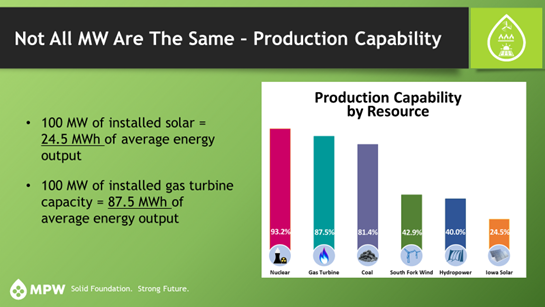Could an “all-source RFP” be used to help determine what mix of resources MPW should use in its power supply portfolio?
All-source RFPs involve a process in which utilities issue requests for proposals for electricity generation facilities of all types. The RFPs will typically specify the amount of generation capacity and/or energy that is needed, but let responders submit proposals for different types of resources (e.g. gas-fired, solar, wind, nuclear, etc). Sometimes, an all-source RFP is broken out into two categories – intermittent resources (e.g. solar, wind) and dispatchable resources (e.g. gas-fired, coal-fired, nuclear). The result of the RFP process is that the utility has fairly firm pricing information for several different resource options. This process is sometimes used to get pricing data to feed into a power supply study or it can be used to directly lead to contracts to secure the resources.
It is very important to note that all-source RFPs do not replace comprehensive power supply planning like MPW has underway. They can be used to help feed information into a comprehensive power supply study and/or validate assumptions used in a power supply study. All-source RFPs are not intended to have developers provide proposals that include a comprehensive, 24/7, contingency-proof power supply. They are opportunities to receive pricing for different types and sizes of projects that feed into a more comprehensive plan. That information can be very useful, but it is important to understand some key limitations in what an all-source RFP can achieve.
All-source RFPs are sometimes portrayed as a fair and open way to compare proposals for projects from all technologies so that an apples-to-apples comparison can be conducted. The challenge, however, is that the power generation technology options available today are very different in their ability to provide power to the system. As an example:
- A 100-megawatt (MW) wind farm only offers about 20MW of capacity credit, so from a capacity perspective, if you compare proposals of a 100MW wind farm to that of a 100MW gas-fired combustion turbine, the wind resource is only equivalent to about 20% of that of the gas unit.
- Similarly, on an energy production basis, a 100MW solar resource only produces an average of about 25MW worth of energy over the course of the year (i.e. 25% capacity factor), whereas 100MW of baseload gas-fired plant or nuclear plant would produce an average of 85 – 95MW (i.e. 80%-95% capacity factor).

If MPW would put out an all-source RFP for 100MW of generation resources, we would get pricing on a $/MWH basis for all types of units, but the actual capacity credit, annual energy production, and ability to support the system would be dramatically different and often not included in the comparison.
An important factor in evaluating all-source RFP responses is to consider the location of the resource and pricing it could receive from the wholesale market. Some projects may have an attractive contract price but may receive very poor market pricing. This is typical for many wind projects in the MISO market. The result could be that the net financial impact to MPW could be significantly more costly than what the seemingly low contract price would indicate.
Another important factor is that MPW has unique opportunities in Muscatine. We have an industrial customer with a large process steam demand. MPW has over 20 years of direct experience operating a Combined Heat & Power (CHP) system, including managing the contractual relationships, operating the complex processes of the system, and participating in the wholesale market. The specific details of this type of application are unique and specific to our circumstance. A typical all-source RFP process would not include proposals for such a unique system. To truly leverage this unique opportunity, we need to evaluate it on a more specific basis.













